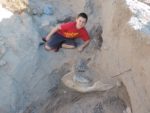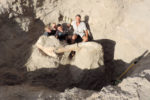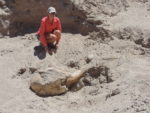 Nine-year-old Jude Sparks was hiking with his family in the desert of Las Cruces, New Mexico, last November testing walkie-talkies with his younger brothers when he tripped on something and fell. He thought it looked like petrified wood at first, but its shape seemed more animal than plant. Could it be that classic of desert art, the cow skull? That’s what his little brother Hunter thought. Jude’s parents thought it looked more elephant-like. They looked it up when they got home and none of the elephant skulls they found online matched the object Jude had stumbled on, so they emailed a photo of the find to Peter Houde, professor of biology at New Mexico State University (NMSU), in the hope he might be able to identify it.
Nine-year-old Jude Sparks was hiking with his family in the desert of Las Cruces, New Mexico, last November testing walkie-talkies with his younger brothers when he tripped on something and fell. He thought it looked like petrified wood at first, but its shape seemed more animal than plant. Could it be that classic of desert art, the cow skull? That’s what his little brother Hunter thought. Jude’s parents thought it looked more elephant-like. They looked it up when they got home and none of the elephant skulls they found online matched the object Jude had stumbled on, so they emailed a photo of the find to Peter Houde, professor of biology at New Mexico State University (NMSU), in the hope he might be able to identify it.
 Houde recognized it at a glance as the fossilized skull of a Stegomastodon, a large elephantine animal that roamed North America in the Pliocene era about five million to 28,000 years before the present. This particular specimen is approximately 1.2 million years old, and even though it’s from one of the more common species of extinct elephants that inhabited the area, as far as Houde knows it’s only the second complete Stegomastodon skull discovered in New Mexico.
Houde recognized it at a glance as the fossilized skull of a Stegomastodon, a large elephantine animal that roamed North America in the Pliocene era about five million to 28,000 years before the present. This particular specimen is approximately 1.2 million years old, and even though it’s from one of the more common species of extinct elephants that inhabited the area, as far as Houde knows it’s only the second complete Stegomastodon skull discovered in New Mexico.
 Jude had tripped over one of its tusks and faceplanted in front of the lower mandible. He could see the second tusk a little ways away. It was an incredibly fortuitous stumble, because the fossil had only recently been exposed by heavy rains. Had it been exposed to the elements any longer, it would have crumbled to dust. Houde saw to it that the exposed fossils parts — the jaw and both tusks — were removed to NMSU’s Vertebrate Museum for their protection. After securing the permission of the landowner (the exact location of the find is being kept under wraps at his request) and the hardening chemicals necessary to preserve the fossil in situ, Peter Houde and a team of professors and students excavated the rest of the skull this May. The Sparks family was given the opportunity to join in the excavation, which is going to be hard to top as family excursions go.
Jude had tripped over one of its tusks and faceplanted in front of the lower mandible. He could see the second tusk a little ways away. It was an incredibly fortuitous stumble, because the fossil had only recently been exposed by heavy rains. Had it been exposed to the elements any longer, it would have crumbled to dust. Houde saw to it that the exposed fossils parts — the jaw and both tusks — were removed to NMSU’s Vertebrate Museum for their protection. After securing the permission of the landowner (the exact location of the find is being kept under wraps at his request) and the hardening chemicals necessary to preserve the fossil in situ, Peter Houde and a team of professors and students excavated the rest of the skull this May. The Sparks family was given the opportunity to join in the excavation, which is going to be hard to top as family excursions go.
Houde applauded the Sparks family’s decision to do the right thing in contacting him about their find. He encourages others who might come across fossils to reach out to an expert rather than try to dig it up on their own.
“As you can imagine, when people find out about these things, they might be tempted to go out there and see what they might find themselves and tear up the land or they might hurt themselves,” Houde said. “To be quite honest, all these fossils from this area are radioactive and especially for children, not something you would want in your home.”
Houde estimates the jaw weighs about 120 pounds and the entire skull as little as a ton. And while the skull may appear to be strong, it is quite delicate.
“The upper part of the skull is deceiving. It’s mostly hollow and the surface of the skull is eggshell thin,” Houde said. “You can imagine an extremely large skull would be very heavy for the animal if it didn’t have air inside it to lighten it up just like our own sinuses. That makes the thing extremely fragile and the only thing holding it together is the sediment surrounding it.
“In fact when the sediments are removed from the sides of them, they start to fall apart immediately and literally fall into tiny, tiny bits. It has to be done carefully by somebody who knows how to go about doing it. It is a very deliberate process that takes a little bit of time.”
 The team spent a week excavating the skull, brushing it with the hardening chemicals to make it possible to remove it without damaging the delicate fossil. Once it was fully exposed, the skull was coated with a layer of plaster and reinforced with wood braces for support. It was raised by a tractor onto a flatbed truck and transported to New Mexico State University.
The team spent a week excavating the skull, brushing it with the hardening chemicals to make it possible to remove it without damaging the delicate fossil. Once it was fully exposed, the skull was coated with a layer of plaster and reinforced with wood braces for support. It was raised by a tractor onto a flatbed truck and transported to New Mexico State University.
In the NMSU laboratory the skull will be studied, analyzed and reconstructed. The process is a painstaking one and it will likely take years before the complete skull is pieced back together and stabilized so it can be put on public display.
Child bitten by radioactive skeletal mastodon granted all the powers of an undead elephant!
Utterly off-topic.
This morning’s Telegraph carries a rave review of a production of Richard III staged in Leicester Cathedral, where the aforesaid has recently been re-interred. You’ll remember the “skeleton under the car park” case.
The touring company Antic Disposition is going to put on this production at other cathedrals: Gloucester, Bristol, Salisbury next.
I thought that anyone coming to Britain this summer might like to know.
As a resident of New Mexico, I am very pleased the professor at NMSU included the family in the excavation. Since it was radioactive, I think it was found in the Alamogordo/ White Sands area.
I was going to share this on facebook, but no preview photo comes up. I’ve shared before without the photo, but I guess all my friends need a photo to tempt them to read something.
I love your blog and that your photos open to a full screen when reading it. Thanks for covering so many interesting things. You’re right at the top on my igoogle homepage.
I’ll bet little Jude becomes a paleontologist now, with that amazing discovery!
Well done, kid! Can’t wait to read your summer vacation report.
Good for him!
I was about that age when my cousin and I found a heavy, spongy metallic rock the size of a soccer ball, that had washed out of a creek bank. We were sure it was a meteorite, so we carried heavy thing more than a mile back to the house to show it off, sure we were bound for fame and wealth. My Grandpa took one look at it and said, “That’s bog iron.”
From then on it was our doorstop and dubbed “The Moon Rock” in honor of the Moon landing later that summer.